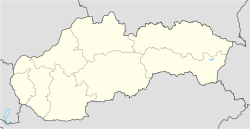Dolné Saliby
Alsószeli | |
|---|---|
Village | |
 Church of Saint John the Baptist | |
| Coordinates: 48°06′00″N 17°47′00″E / 48.10000°N 17.78333°E | |
| Country | Slovakia |
| Region | Trnava |
| District | Galanta |
| First mentioned | 1158 |
| Government | |
| • Mayor | Lajos Kovács (SMK-MKP) |
| Area | |
| • Total | 18.68[2] km2 (7.21[2] sq mi) |
| Elevation | 115[3] m (377[3] ft) |
| Population (2021) | |
| • Total | 2,012[1] |
| Postal code | 925 02[3] |
| Area code | +421 31[3] |
| Car plate | GA |
| Website | https://dolnesaliby.sk/ |
Dolné Saliby (Hungarian: Alsószeli) is a village and municipality in Galanta District of the Trnava Region of south-west Slovakia.
YouTube Encyclopedic
-
1/2Views:5 6662 626
-
Obec Horné Saliby
-
Galanta (Galánta) - Topoľníky (Nyárasd)
Transcription
Geography
The municipality lies at an elevation of 116 metres and covers an area of 18.717 km². It has a population of about 1,957 people.
History
In the 9th century, the territory of Dolné Saliby became part of the Kingdom of Hungary. In historical records the village was first mentioned in 1158. Before the establishment of independent Czechoslovakia in 1918, it was part of Pozsony County. After the Austro-Hungarian army disintegrated in November 1918, Czechoslovak troops occupied the area, later acknowledged internationally by the Treaty of Trianon. Between 1938 and 1945 Dolné Saliby once more became part of Miklós Horthy's Hungary through the First Vienna Award. From 1945 until the Velvet Divorce, it was part of Czechoslovakia. Since then it has been part of Slovakia.
Genealogical resources
The records for genealogical research are available at the state archive "Statny Archiv in Bratislava, Banska Bystrica, Bytca, Kosice, Levoca, Nitra, Presov, Slovakia"
- Roman Catholic church records (births/marriages/deaths): 1678-1931 (parish B)
- Lutheran church records (births/marriages/deaths): 1784-1896 (parish A)
- Reformated church records (births/marriages/deaths): 1792-1896 (parish B)
See also
References
- ^ "Počet obyvateľov podľa pohlavia - obce (ročne)". www.statistics.sk (in Slovak). Statistical Office of the Slovak Republic. 2022-03-31. Retrieved 2022-03-31.
- ^ a b "Hustota obyvateľstva - obce [om7014rr_ukaz: Rozloha (Štvorcový meter)]". www.statistics.sk (in Slovak). Statistical Office of the Slovak Republic. 2022-03-31. Retrieved 2022-03-31.
- ^ a b c d "Základná charakteristika". www.statistics.sk (in Slovak). Statistical Office of the Slovak Republic. 2015-04-17. Retrieved 2022-03-31.
- ^ a b "Hustota obyvateľstva - obce". www.statistics.sk (in Slovak). Statistical Office of the Slovak Republic. 2022-03-31. Retrieved 2022-03-31.
External links
- https://web.archive.org/web/20071116010355/http://www.statistics.sk/mosmis/eng/run.html
- Surnames of living people in Dolne Saliby

